Scientists study modern snails, shed light on ancient humans?
By Eryn Brown
Genetic analysis of certain snails in Ireland suggests that the creeping mollusks may have arrived on the Emerald Isle when humans carried them there some 8,000 years ago — all the way from the Pyrenees Mountains between France and Spain.
In a study published Wednesday in the journal PLOS ONE, University of Nottingham researchers Angus Davison and Adele Grindon described how they examined DNA samples cut from the foot muscles of 880 separate individuals of the common land snail species Cepaea nemoralis. The snails, which represented 111 separate populations, were collected by researchers and volunteers throughout Europe between 2005 and 2007.
Analyzing a fragment of DNA from the mitochondrial gene COI from each sampled snail, the researchers found that most of the snails they studied from Ireland shared their genetic lineage with snails from Andorra and the eastern Pyrenees — but with few other snails from anywhere else in Europe, including nearby Britain.
The simplest explanation, they wrote, is that the snails came to Ireland in a “single historic long disperal event.”
“What we’re actually seeing might be the long lasting legacy of snails that hitched a ride, accidentally or perhaps as food, as humans traveled from the South of France to Ireland 8,000 year ago,” Davison said, in a statement.
A range of archaeological evidence supporting that interpretation, he and Grindon wrote, including “deep middens of burnt shells…found during Pyrenean cave excavations” which indicate “that humans have either been collecting or possibly ‘farming’ land snails for thousands of years, with the majority of these shells being C. nemoralis.”
In the introduction to their study, Davison and Grindon also noted that scientists have long been curious about species that are exclusive just to Ireland and the Pyrenees, including the strawberry tree, the Kerry slug and the Pyrenean glass snail. Back in 1846, the naturalist Edward Forbes called the pattern “Lusitanian.”
“If other Irish species have a similarly cryptic Lusitanian element,” Davison and Grindon wrote, ” then this raises the possibility of a more widespread and significant pattern.”
But it will take more DNA studies, they added, to know for sure that such a pattern really exists.



